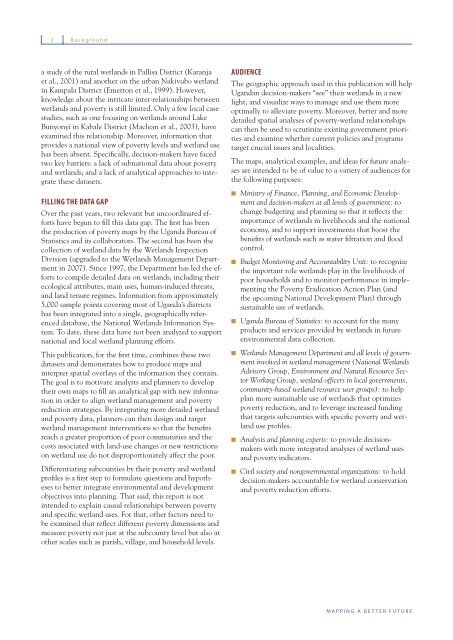Mapping a Better Future - World Resources Institute
Mapping a Better Future - World Resources Institute
Mapping a Better Future - World Resources Institute
You also want an ePaper? Increase the reach of your titles
YUMPU automatically turns print PDFs into web optimized ePapers that Google loves.
2 Background<br />
a study of the rural wetlands in Pallisa District (Karanja<br />
et al., 2001) and another on the urban Nakivubo wetland<br />
in Kampala District (Emerton et al., 1999). However,<br />
knowledge about the intricate inter-relationships between<br />
wetlands and poverty is still limited. Only a few local case<br />
studies, such as one focusing on wetlands around Lake<br />
Bunyonyi in Kabale District (Maclean et al., 2003), have<br />
examined this relationship. Moreover, information that<br />
provides a national view of poverty levels and wetland use<br />
has been absent. Specifi cally, decision-makers have faced<br />
two key barriers: a lack of subnational data about poverty<br />
and wetlands; and a lack of analytical approaches to integrate<br />
these datasets.<br />
FILLING THE DATA GAP<br />
Over the past years, two relevant but uncoordinated efforts<br />
have begun to fi ll this data gap. The fi rst has been<br />
the production of poverty maps by the Uganda Bureau of<br />
Statistics and its collaborators. The second has been the<br />
collection of wetland data by the Wetlands Inspection<br />
Division (upgraded to the Wetlands Management Department<br />
in 2007). Since 1997, the Department has led the efforts<br />
to compile detailed data on wetlands, including their<br />
ecological attributes, main uses, human-induced threats,<br />
and land tenure regimes. Information from approximately<br />
5,000 sample points covering most of Uganda’s districts<br />
has been integrated into a single, geographically referenced<br />
database, the National Wetlands Information System.<br />
To date, these data have not been analyzed to support<br />
national and local wetland planning efforts.<br />
This publication, for the fi rst time, combines these two<br />
datasets and demonstrates how to produce maps and<br />
interpret spatial overlays of the information they contain.<br />
The goal is to motivate analysts and planners to develop<br />
their own maps to fi ll an analytical gap with new information<br />
in order to align wetland management and poverty<br />
reduction strategies. By integrating more detailed wetland<br />
and poverty data, planners can then design and target<br />
wetland management interventions so that the benefi ts<br />
reach a greater proportion of poor communities and the<br />
costs associated with land-use changes or new restrictions<br />
on wetland use do not disproportionately affect the poor.<br />
Differentiating subcounties by their poverty and wetland<br />
profi les is a fi rst step to formulate questions and hypotheses<br />
to better integrate environmental and development<br />
objectives into planning. That said, this report is not<br />
intended to explain causal relationships between poverty<br />
and specifi c wetland uses. For that, other factors need to<br />
be examined that refl ect different poverty dimensions and<br />
measure poverty not just at the subcounty level but also at<br />
other scales such as parish, village, and household levels.<br />
AUDIENCE<br />
The geographic approach used in this publication will help<br />
Ugandan decision-makers “see” their wetlands in a new<br />
light, and visualize ways to manage and use them more<br />
optimally to alleviate poverty. Moreover, better and more<br />
detailed spatial analyses of poverty-wetland relationships<br />
can then be used to scrutinize existing government priorities<br />
and examine whether current policies and programs<br />
target crucial issues and localities.<br />
The maps, analytical examples, and ideas for future analyses<br />
are intended to be of value to a variety of audiences for<br />
the following purposes:<br />
Ministry of Finance, Planning, and Economic Development<br />
and decision-makers at all levels of government: to<br />
change budgeting and planning so that it refl ects the<br />
importance of wetlands in livelihoods and the national<br />
economy, and to support investments that boost the<br />
benefi ts of wetlands such as water fi ltration and fl ood<br />
control.<br />
Budget Monitoring and Accountability Unit: to recognize<br />
the important role wetlands play in the livelihoods of<br />
poor households and to monitor performance in implementing<br />
the Poverty Eradication Action Plan (and<br />
the upcoming National Development Plan) through<br />
sustainable use of wetlands.<br />
Uganda Bureau of Statistics: to account for the many<br />
products and services provided by wetlands in future<br />
environmental data collection.<br />
Wetlands Management Department and all levels of government<br />
involved in wetland management (National Wetlands<br />
Advisory Group, Environment and Natural Resource Sector<br />
Working Group, wetland offi cers in local governments,<br />
community-based wetland resource user groups): to help<br />
plan more sustainable use of wetlands that optimizes<br />
poverty reduction, and to leverage increased funding<br />
that targets subcounties with specifi c poverty and wetland<br />
use profi les.<br />
Analysts and planning experts: to provide decisionmakers<br />
with more integrated analyses of wetland uses<br />
and poverty indicators.<br />
Civil society and nongovernmental organizations: to hold<br />
decision-makers accountable for wetland conservation<br />
and poverty reduction efforts.<br />
MAPPING A BETTER FUTURE

















